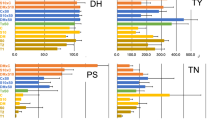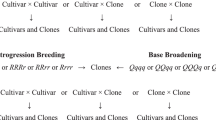Summary
Progeny families of 4x−2x hybrids between Group Tuberosum and Group Phureja-haploid Group Tuberosum hybrids were evaluated under simulated commercial agricultural practices in 1974 and 1975. The range of the observed values for the 4x−2x hybrids exceeded the range of the 4x parents for nearly all measured traits. The mean for total yield of the 4x−2x hybrids was equal to (1974 experiment or significantly higher (1975 experiment) than the mean of the 4x parents. In the 1975 experiment 17.8% of the 4x−2x hybrids produced a higher total yield than the highest yielding 4x parents. The 4x−2x hybrids exhibited a significantly lower mean than the 4x parents for marketable yield and tuber weight but transgressive segregants were found for these traits in both experiments. The heterosis and variability of the hybrids indicates that this breeding method is a potentially powerful tool in potato improvement.
Zusammenfassung
Zwei Gruppen von Phureja-haploiden Tuberosumhybriden, von denen bekannt ist, dass sie diplandroide Gameten durch den Parallelspindelmechanismus bilden, wurden als männliche Elternteile für verschiedene weibliche Eltern der Gruppe Tuberosum benutzt (Tabelle 1). Nachkommenschaften aus 4x−2x-Kreuzungen wurden 1974 und 1975 unter ähnlichen landwirtschaftlichen Bedingungen geprüft. Der Schwankungsbereich der gemessenen Werte für die 4x−2x Hybriden überstieg den der 4x Eltern in nahezu allen gemessenen Merkmalen in beiden Versuchen. Die 4x−2x Hybriden hatten einen signifikant niedrigeren Durchschnittswert für marktfähigen Ertrag und Knollengewicht, aber in beiden Versuchen wurden transgressive Abweichungen für diese Merkmale gefunden (Tabelle 2). 1975 ergaben 17.8% der 4x−2x Hybriden einen höheren Gesamtertrag als die besten 4x Eltern (Abb. 1).
1975 wurden hoch signifikante Unterschiede bei fast alle gemessenen Merkmalen zwischen Familien gefunden, die von verschiedenen 4x Eltern abstammen (Tabelle 3). Das deutet auf beträchtliche Unterschiede dieser Merkmale in der allgemeinen Kombinationsfähigkeit in den 4x Eltern hin. Unterschiede in der allgemeinen Kombinationsfähigkeit bestehen auch zwischen den zwei 2x Eltern (Tabellen 3 und 4). Zwischen den 4x und 2x Eltern konnten keine signifikanten Wechselwirkungen beobachtet werden (Tabelle 3).
Das Gesamtergebnis der 4x−2x Hybriden war sehr ermutigend. Ein breiterer Gebrauch dieser Züchtungsmethode hängt von der Entwicklung kultivierter diploider Eltern ab, in denen das Merkmal diplandroider Bildung mit relativ früher Reife und anderen Eigenschaften wie Knollenform und Augentiefe kombiniert ist. Wenn solche Klone verfügbar werden, werden die Kartoffelzüchter ein noch mächtigeres Werkzeug haben, um Zuchtstämme und Sorten mit hohen Erträgen zu züchten.
Résumé
Deux hybrides issus du groupe Phureja haploïde-groupe Tuberosum, connus pour leurs gamètes diplandres obtenus par le mécanisme du fuseau parallèle, ont été utilisés comme géniteurs mâles, avec plusieurs géniteurs femelles du groupe Tuberosum (tableau 1).
La descendance d'hybrides 4x−2x a été étudiée dans des conditions similaires à celles de la pratique en 1974 et 1975. Le classement des valeurs observées pour les hybrides 4x−2x est supérieur à celui des géniteurs 4x pour presque tous les critères évalués dans les deux essais. Les hybrides 4x−2x ont en moyenne un rendement commercialisable et un poids par tubercule significativement inférieurs aux géniteurs 4x, mais une transgression est observée pour ces caractères dans les deux essais (tableau 2).
Dans l'essai de 1975, 17,8% des hybrides 4x−2x ont donné un rendement total supérieur aux meilleurs géniteurs 4x (fig. 1).
Des différences hautement significatives ont été mises en évidence en 1974 pour presque tous les critères mesurés, entre des familles issues de différents géniteurs 4x (tableau 3). Ceci suggère qu'il existe en général de grandes différences dans l'aptitude à la recombinaison de ces critères parmi les géniteurs l'aptitude à la recombinaison de ces critères parmi les géniteurs 4x. Des différences se retrouvent également entre les parents 2x (tableaux 3 et 4). Aucune intéraction significative n'a pu être détectée entre les géniteurs 4x et 2x (tableau 3).
Les résultats obtenus avec les hybrides 4x−2x sont très encourageants. Une plus large utilisation de cette méthode suppose l'obtention de géniteurs diploïdes dans lesquels la formation du caractère diplandre est associée à une maturité relativement plus précoce et à d'autres caractéristiques agronomiques telles que le type de tubercule et la profondeur des yeux. Quand de tels clones seront disponibles, les obteneurs auront un outil encore plus puissant pour produire du matériel génétique de haut rendement et des variétés.
Similar content being viewed by others
References
Hanneman, R. E. Jr. & S. J. Peloquin, 1969. Use of Phureja and haploids to enhance the yield of cultivated tetraploid potatoes.Am. Potato J. 46: 436.
Kidane-Mariam, H.-M. & S. J. Peloquin, 1974. The effect of direction of hybridization (4x · 2x vs. 2x · 4x) on yield of cultivated potatoes.Am. Potato J. 51: 330–336.
Mendiburu, A. O., 1971. The significance of 2n gametes in potato breeding and genetics. Ph.D. Thesis. University of Wisconsin, 89 pp. University Microfilms. Ann Arbor. Mich. (Diss. Abstr. 32: 1387B.)
Mendiburu, A. O., S. J. Peloquin & D. W. S. Mok. 1974. Potato breeding with haploids and 2n gametes. In: K. J. Kasha (Ed.), Haploids in higher plants. Advances and potential, p. 249–258. University of Guelph, Guelph.
Mok, D. W. S. & S. J. Peloquin, 1975a. Breeding value of 2n pollen (diplandroids) in tetraploid diploid crosses in potatoes.Theor. appl. Genet. 46: 307–314.
Mok, D. W. S. & S. J. Peloquin, 1975b. Three mechanisms of 2n pollen formation in diploid potatoes.Canad. J. Genet. Cytol. 17: 217–225.
Mok, D. W. S. & S. J. Peloquin, 1975c. The inheritance of three mechanisms of diplandroid (2n pollen) formation in diploid potatoes.Heredity 35: 295–302.
Myers, J. L., 1966. Fundamentals of experimental design. Allyn and Bacon, Boston, 407 pp.
Quinn, A. A., D. W. S. Mok & S. J. Peloquin, 1974. Distribution and significance of diplandroids among the diploid Solanums.Am. Potato. J. 51: 16–21.
Quinn, A. A. & S. J. Peloquin, 1973. Use of experimental tetraploids in potato breeding.Am. Potato J. 50: 415–420.
Tai, G. C. C., 1974. A method for quantitative genetic analysis of early clonal generation seedling of an asexual crop with special application to a breeding population of the potato (Solanum tuberosum L.).Theor. appl. Genet. 45: 150–156.
Tarn, T. R. & G. C. C. Tai, 1977. Heterosis and variation of yield components in F1 hybrids between Group Tuberosum and Group Andigena potatoes.Crop Sci. (in press).
Author information
Authors and Affiliations
Rights and permissions
About this article
Cite this article
De Jong, H., Tai, G.C.C. Analysis of tetraploid-diploid hybrids in cultivated potatoes. Potato Res 20, 111–121 (1977). https://doi.org/10.1007/BF02360270
Accepted:
Issue Date:
DOI: https://doi.org/10.1007/BF02360270




